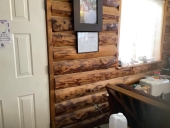posted 7 years ago
The main reason that Tyvek is popular is that it allows water vapor to pass through it without allowing water or wind to pass. This helps to keep the inside of the wall dryer.
Taped plywood is less permeable so it's more likely to end up having water condense on it.
If where you live experiences even short periods of hot humid weather, then condensation inside the wall may be a concern. If the hot, moist air gets through the ship lap it could condense on the cooler plywood within and now you have water inside your wall where it will cause mold, fungus, etc.
I live in a desert that experiences a monsoon season where the humidity can reach 100% at night. When they first started building stucco houses decades ago one of the major problems they had with it was humid air getting through holes, cracks, etc. and condensing inside the wall where it would rot out the wood framing. Tyvek (or similar products) inside the stucco, but outside the wood framing, was one of the ways they solved this problem.
My opinions are barely worth the paper they are written on here, but hopefully they can spark some new ideas, or at least a different train of thought





